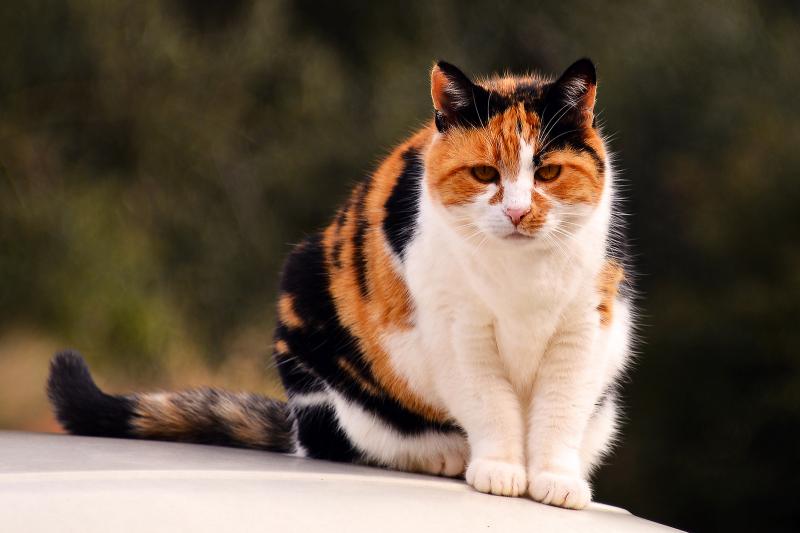The obesity epidemic in this country has not been lost on our calico cat for sale. A 2011 study by the APOP (Association for Pet Obesity Prevention), stated that more than 50% of domestic cats are considered overweight or obese. Feline obesity is responsible for numerous diseases and disorders, including feline diabetes, arthritis, respiratory problems, heart disease, and liver disease, most of which can be eliminated once your cat is back to a normal weight. Armed with an understanding of feline obesity and a weight management strategy, it is possible to get kitty back to a healthy weight.
Physical Activity – Cats gain weight the same way humans do, by consuming more calories than they burn. In nature, food acquisition requires physical exertion. Animals in the wild never know when or where their next meal will be making an appearance, so they are frequently on the hunt. Hunting for food requires a great deal of physical activity. With the domestication of cats, the need to hunt as a means of survival is no longer required; therefore, the physical activity of hunting is not essential.
Nutrition- Cats are strictly carnivorous animals. They were not meant to eat carbohydrates. Cats lack two important enzymes, amylase andglucokinase, which break down and help the body process carbs. Cats have the ability to convert proteins to energy, therefore needing fewer carbs. This results in the unused carbs being stored as fat.
Feeding Schedule- Ad libitum or free-choice feeding is when food is left out for consumption all hours of the day. Free feeding is like being on a kitty cruise ship – 24 hour buffet. Unfortunately, this provides opportunity for cats to feed for reasons other than hunger, including boredom.
1. Make an Appointment with Your Veterinarian – Cats are made of up of different breeds, body types, sizes, etc; therefore, before beginning a weight management program, make an appointment with your veterinarian. Determining the extent of your cat’s weight problem, and whether it could be caused by an underlying medical condition is crucial to your strategy. This is especially important if your cat has put on a few pounds in a short period of time.
2. Keep kitty busy- Cats typically sleep 13-16 hours per day, so making the best of the time when kitty is awake is crucial. Cats need some type of physical activity each day, so set aside a few minutes to focus on playing with your cat. Not only will your cat benefit from the exercise, you both will benefit from the time spent together. With so many cat toys on the market, you should have no problem finding one that your cat will love. Here are some of our favorites
3. Read labels- The Association of American Feed Control Officials (AAFCO) suggests that you look for the following information when reading cat food labels to ensure that the food you are purchasing falls within the recommended guidelines.
If your cat is severely overweight or has a weight related health issue, there are a number of prescription cat foods that are formulated for specific needs. Please contact your veterinarian for guidance on which food would be best suited for your cat.
4. Implement a feeding schedule- If you have been free-feeding your cat, then you will need to slowly transition to scheduled feedings. Obese cats who are deprived of food, or whose food intake is greatly restricted can develop hepatic lipidosis, or Fatty Liver Syndrome, which is a very serious disorder, and left untreated could be fatal. If your cat is already obese, again, it is important to consult with a veterinarian before making any food or feeding changes. He should be able to offer additional tips on how to transition to a feeding schedule without risking the health of your cat. A change in feeding schedule can also help your cat maintain a healthy weight, thus reducing the chances of obesity related health problems later in life. In addition, a scheduled feeding plan is a good way to keep track of your cat’s food intake.
Begin by determining the appropriate food portion for your cat based on the packaging guidelines. Place half that amount in her bowl each morning, and encourage her to eat at that time. After she has finished, remove the bowl. At the next scheduled feeding time, place the remainder of the food in her bowl, and again, encourage her to eat. Since she has not been able to graze during the day, she will probably be grateful and hungry. Again, remove the bowl when she walks away. Eventually she will understand that she needs to eat until she is full at each feeding, since the food will not be available all day. With some time and patience you should have her on a routine schedule; eating when she is hungry, and eliminating the temptation of eating when she is bored.

More Stories
Safepal: Revolutionizing Cryptocurrency Security with Cutting-Edge Solutions
MetaMask: Bridging the Gap Between Users and the Decentralized Web
The Salt Trick: A Surprising and Versatile Solution to Everyday Problems